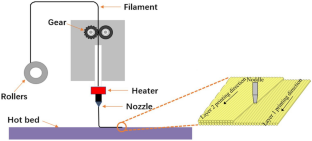Exploring Flexural Performances of Fused Filament Fabrication 3D-Printed ABS and ABS-Composites through Innovative Bio-Inspired Processing Parameter Optimization
Abstract
Taking crustacean organisms in nature as prototypes helps improve the design of protective gears. Drawing inspiration from the high-damage-tolerance helical-structured cuticle of the American crayfish, we conduct an optimization of processing parameters for Fused Filament Fabrication 3D printing products. Various values of in-plane raster angle and interlayer thickness are employed to replicate the damage-resistant feature mimicked from nature. The effect of flexural resistances on 3D-printed three-point bending specimens is being investigated using a combination of four helical printing raster angles at four different layer thicknesses. Acrylonitrile-butadiene-styrene (ABS) and glass fiber-reinforced ABS (ABS-GF) are employed as material models. A Dino-lite handheld microscope and a Keyence VHX-7000 optical microscope are used to characterize the microstructure of the samples’ fracture resistance after the three-point bending test. Explanations of the mechanism of fracture resistance for helical structures are given. The results show that the specimen with a layer thickness of 0.04 mm and a spiral angle of 30° has the highest bending strength and bending elastic modulus among all the tested specimens. When compared with the layer thickness of 0.16 mm, the bending strength and bending elastic modulus of the ABS helix specimen with a layer thickness of 0.04 mm are increased by 6.45% and 2.67%, and those of the ABS-GF helix specimen are increased by 21.21% and 10.03%, respectively. The microstructural observation of the samples reveals that the spiral specimens with a helix angle of 11.25° have a greater displacement of crack propagation to resist the damage extending inside when resisting fracture. Our bio-inspired study presents an alternative approach to comprehensively optimize FFF printing parameters for enhanced mechanical performance.
Graphical Abstract


 求助内容:
求助内容: 应助结果提醒方式:
应助结果提醒方式:


